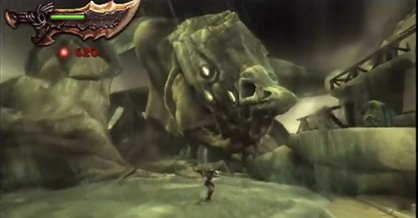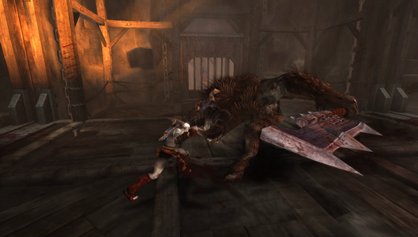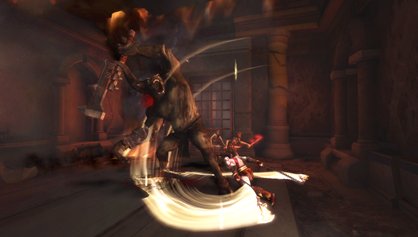E3 2010: Hands-on with God of War: Ghost of Sparta
Kratos' next PSP monster-stomp already looks as brutal as its full-sized predecessors
It also wouldn’t be God of War without quick time events, which came into play during the first big fight against Scylla. After the deck was cleared of her clinging tentacles – which could wrap around Kratos, forcing us to jam on the L and R buttons to break free – Scylla ran Kratos’ little ship aground on Atlantis’ rocky shores. The creature then revealed herself (or at least her top half), filling the screen and dwarfing Kratos (like most God of War bosses do). For a handheld game, Ghost of Sparta pulls off an impressive sense of scale, and it didn’t get any less impressive when Kratos hooked Scylla on a massive anchor before leaping in close for a quick time beatdown.

Said beatdown was good and vicious, leaving Scylla with a missing eye and achunk torn out of her jaw, but it also showed off a feature borrowed from God of War III: the button prompts have been moved to the edges of the screen. This means that, rather than ignoring the action to focus on the prompts, you can watch for directional flashes in your peripheral vision while you watch Kratos acrobatically slash Scylla’s mug to ribbons.
After the wounded beast fled, Kratos was left to pick his way through the ruined tunnels underneath Atlantis, which involved a lot of climbing, platforming, swimming, tugging chests open, shimmying along ledges and fighting cannon-fodder fish-men – in short, everything God of War fans have come to expect from the games. The demo also included a tussle with a Minotaur, which was hairier and stockier than the ones we’d fought in earlier GoW games. It also had a pain-in-the-ass charge move, but went down as easily as any of the others.

It was once Kratos actually busted into Atlantis that things really got interesting. We knew he’d reached the city properthe second we saw a group of terrified civilians fleeing from a hulking monster, which cut them all down by hurling huge steel blades through them. It was here that the beasts got tougher, the architecture got more interesting and – at the end of the demo – we met Garon, a four-armed, electrically charged giant who carried a massive ball that he repeatedly slammed into the ground. Oh, and despite being a lumbering thug, he could also teleport.
Outside of Atlantis, we also had a chance to see other, later parts of the game, including a scene – set in some underground, lava-filled tunnels that the developers acted strangely cagey about explaining – involving King Midas, the mythical king who foolishly wished that everything he touched could turn to gold. Here, he was a sobbing, emaciated wretch – but, understandably, didn’t want a monster like Kratos getting near him. To subdue Midas, Kratos restrained him by the wrists and punched him a few times, knocking him out.

Above: Not King Midas
From there, Kratos had to carry Midas’ unconscious body to a cliff overlooking an enormous lava flow, all while smashing monsters and trying to keep Midas from waking up and turning him to gold – something that, unlike being turned to stone by Gorgons, resulted in instant death. As they neared the cliff, Midas woke up and started clawing at the ground, leaving desperate little trails of gold as Kratos dragged him by his ankles. The scene focused closely on Midas’ face, evoking some of the more brutal beatdown scenes from God of War III – but rather than just getting his head smashed or his eyes gouged out, Midas was hurled off the cliff and into the lava. We’re not sure what happens next, but we’re guessing it probably involves the lava suddenly being turned to gold.
Sign up to the GamesRadar+ Newsletter
Weekly digests, tales from the communities you love, and more
Beyond that, there isn’t much else to say about Ghost of Sparta; it’s a God of War game, it plays every bit like a God of War game, it looks amazing for a PSP title and it’s going to be bloody as hell – even to the point where the spattered blood will stay splashed on Kratos, similar to how it did in God of War III. Expect this one to be out sometime late this year.
Jun 22, 2010



